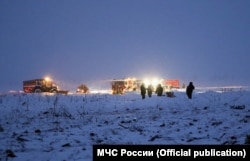Difficult conditions mean the search-and-recovery operation at the snow-packed site of a plane crash outside Moscow that killed all 71 passengers and crew could take a week, Russian authorities say.
"The rescue effort is over. All the 71 people onboard are dead. My sincere condolences to their families and friends," Emergency Situations Minister Vladimir Puchkov told reporters on February 12.
The ministry said that just two bodies had been recovered by late on February 11. Some 400 search-and-rescue workers were being sent to the crash site.
It added that one of the flight recorders was recovered, but it was not immediately clear if it was the data or voice recorder.
Puchkov said the search operation was being made difficult “because we have a big area of scattered wreckage, heavy snow, and complicated ground profile," he said.
The Antonov An-148 operated by Saratov Airlines vanished from radar screens shortly after takeoff on February 11 as it was en route from Moscow’s Domodedovo Airport to Orsk in the Urals, officials said.
"Sixty-five passengers and six crew members were on board, and all of them died," Russia's Office of Transport Investigations said in a statement.
President Vladimir Putin's spokesman, Dmitry Peskov, said Putin “offers his profound condolences to those who lost their relatives in the crash.”
Putin put off a planned trip to the Black Sea resort city of Sochi on February 12 and remained in Moscow. A February 12 meeting with Palestinian Authority President Mahmud Abbas was moved from Sochi to Moscow.
The White House offered its condolences to families of the victims of the crash, saying in a statement that the United States "is deeply saddened by the tragic deaths of those on board Saratov Airlines Flight 703."
"We send our condolences to the families of those who lost their lives and to the people of Russia," the statement added.
Yelena Voronova, a spokeswoman for the airline, identified the pilot as 51-year-old Valery Gubanov, who had 5,000 hours of flight experience, and said the co-pilot, Sergei Gambaryan, was also experienced.
“The crew was experienced; the plane was reliable,” she told the U.S. television network ABC.
Fragments from the plane were found in Ramenskoye district, some 40 kilometers from the airport.
Flight-tracking site Flightradar24 tweeted that the plane was descending at 1,000 meters per minute five minutes after taking off.
The Emergency Situations Ministry website published the official list of passengers and crew.
Most of those on board were from the Orenburg region, where the plane was flying to, local officials said. Three children and two foreign nationals from Switzerland and Azerbaijan were among the passengers.
The Orenburg regional government declared February 12 a day of mourning in the province.
The Transport Ministry was considering weather conditions and human error as possible reasons for the crash, according to Interfax.
Russian officials denied reports that the pilot reported a malfunction.
The aircraft was manufactured by the Voronezh Aircraft Production Company in 2010, the company's press service told TASS.
Domodedovo airport has been the focus of security concerns in the past. In 2004, Chechen suicide bombers destroyed two airliners that took off from the airport on the same evening, killing 90 people. A suicide bombing in the arrivals area killed 37 people in January 2011.
Russia media reported that investigators conducted a search at the airline's main office in Saratov.
Russian airlines have suffered two large-scale plane crashes in recent years: A Tu-154 operated by the Russian Defense Ministry crashed into the Black Sea, killing all 92 people on board on December 25, 2016.
An onboard bomb destroyed a Russian Airbus A321 soon after taking off from Egypt's Sharm al-Sheikh resort, killing 224 people in October 2015.The Islamic State extremist group said it had placed the bomb aboard the plane.
The crash comes after a report by Aviation Safety Network in January that said 2017 was the safest year in commercial aviation in history worldwide.
The report said that 10 airline accidents worldwide with 79 fatalities represented the first year with fewer than 100 deaths among records dating to 1946













